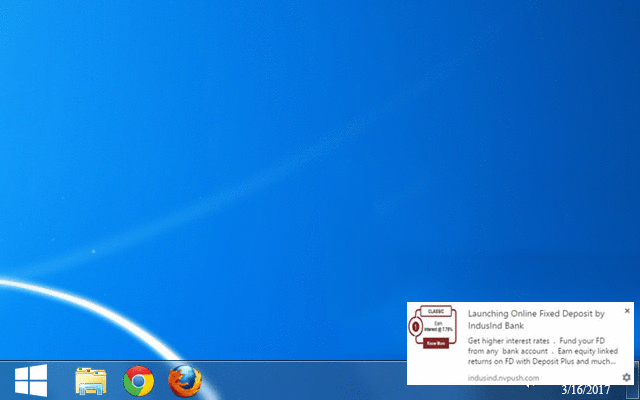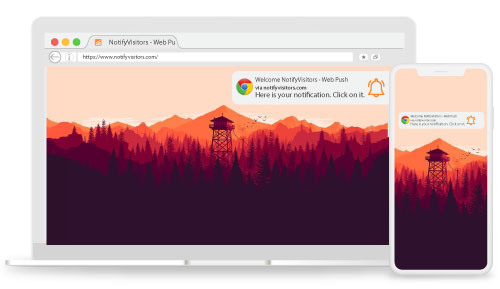Email marketing is slowly decreasing in usage, while social media has taken over. While the latter is an exciting, fun and informal platform to share your business prospects; studies show that you actually create revenue or have an interaction with only 0.07% of Facebook and 0.03% of twitter audience.
Social media thus is a difficult tool to reach your users especially when you want a direct response to your product. This is where Web Push Notifications comes to your rescue.
To understand a push notification let’s take the example of an installed YouTube App on your phone. Every time your subscribed YouTube channel uploads a new video you get a pop-up message or notification stating the same. These are similar notifications, however, from a website that you visit regularly or for a prolonged time. It happens when the page visitor grants permission to the service window to allow the website to send these.

Push notifications are nothing but pop-ups on your system that is received when you subscribe to a website. Thus you do not have to daily check your website for regular developments; a notification is sent to your device; clicking on which lands you to the appropriate page with the update. These are very similar to your App Notifications except that you do not require installing the app for updates or notifications. Browser Push Notifications can be assessed on all devices irrespective of your browser.
Browser Push Notification works on approximately 85% of devices and browsers. This marketing channels grants instant response and keeps your visitors engaged on the website. No information like email ID, contact no, etc. needs to be taken from the visitors.

Contents
Web Push is not to be confused with In-Browser Notifications.
While the latter requires a dedicated audience to open the website for information; the former can be used to either announce the same information or provide an update like a sale /offer on products/services or a new blog post.
NOTE: Web notification is highly advised and used on HTTPS. Though the same can be implemented on HTTP; it is avoided to ensure that the notification is not a man-in-the-middle-attack. The ones that appear on non-secure domains are usually corrupt files.
All browsers allow notifications to be sent via their own server on all devices; iOS Safari does not allow to send these on their Tablets or Mobile.
Why is it gaining importance?
The main reason why Web Push is gaining importance is that of its ability to act like a native app being a website. It is precise in nature, provides valid information on time and is only sent to users who seek its benefit. A perfect combination of these three elements grant you the desired action from a positive lead and only add to productivity.
Here is a list of benefits for blog writers and large-scale enterprises that can be achieved by using Web Push Notification.
• Wider market reach – Prominent browsers like Chrome, Safari, and Firefox have approximately 80% share in the market. All these support Browser Push Notifications that will only optimize business opportunities. It also provides a regular interaction with the viewers of your website.
• Reduced App and Email Requirement – Does not rely on an app to regularly update prospective users. The same can be notified about the latest news on the website and a track of the same can be kept to understand user preferences.
• Reduced Dependability – Users who are not on your website and online can be reached, unlike in-browser notifications. Dependency on information provided by website visitors like phone no, email ID is reduced. Audience reach through Facebook, Twitter or any other Social is effective but very slow and low when compared to Web Push.
• Opt-in and Opt-out – Unlike emails, which often go unread or as spam by subscribers, the ability to opt in and out of receiving notifications is easier. The response from users is 70% higher in opt-in than from emails or website visits.
• Delivery of Content – Notifications do not end up as spam emails and get attention from the viewer. Clicking the same leads them to the exact web page desired by the brand which was a little tricky with emails and messages. Hence, assuring higher conversion rates, ROI, more reads on blogs and an assured response. Web and App Notifications have a 50% higher performance rate and the favorable rate of clicks when compared to other mediums.
• Time and Target– Timely update on sales and discounts and blogs is beneficial to both the brand and receiver. Most of those who subscribe are tech-savvy and chose this option as they want to. This guarantees you a desired and targeted audience that is specifically interested in your brand or product. If customizations are provided they show a deeper interest towards the website.

























 Email
Email SMS
SMS Whatsapp
Whatsapp Web Push
Web Push App Push
App Push Popups
Popups Channel A/B Testing
Channel A/B Testing  Control groups Analysis
Control groups Analysis Frequency Capping
Frequency Capping Funnel Analysis
Funnel Analysis Cohort Analysis
Cohort Analysis RFM Analysis
RFM Analysis Signup Forms
Signup Forms Surveys
Surveys NPS
NPS Landing pages personalization
Landing pages personalization  Website A/B Testing
Website A/B Testing  PWA/TWA
PWA/TWA Heatmaps
Heatmaps Session Recording
Session Recording Wix
Wix Shopify
Shopify Magento
Magento Woocommerce
Woocommerce eCommerce D2C
eCommerce D2C  Mutual Funds
Mutual Funds Insurance
Insurance Lending
Lending  Recipes
Recipes  Product Updates
Product Updates App Marketplace
App Marketplace Academy
Academy


